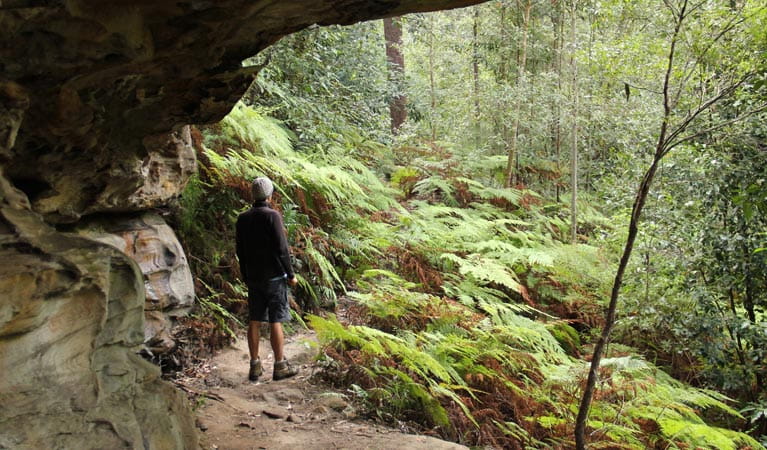Dharug National Park
Overview
Explore the World Heritage-listed Old Great North Road, go camping, mountain biking or canoeing at Dharug National Park near Wisemans Ferry, northwest of Sydney.
Read more about Dharug National Park
Dharug National Park covers rugged bushland just north of the Hawkesbury river, with dramatic sandstone cliffs and a variety of natural habitats. It’s the perfect place to escape to on a daytrip or for a weekend getaway.
There is loads to explore; take a walk, mountain bike or guided tour into history along the Old Great North Road - World Heritage walk; built by up to 720 convicts between 1826 and 1836. Download the Convict Road app before heading out to accompany you along the track. Take a canoe or kayak out to explore the Hawkesbury river or camp out under the stars at Mill creek or Ten Mile Hollow campground.
The park is bursting with bird and animal life, you’re likely to see gang-gang cockatoos, satin bowerbirds and green catbirds on the mountain slopes and, if you’re camping overnight, be sure to take a torch to look for yellow-bellied and greater gliders and sugar gliders. If you can’t see the yellow-bellied glider, you may well hear their loud shrieking and gurgling calls.
Local alerts
For the latest updates on fires, closures and other alerts in this area, see https://www.nationalparks.nsw.gov.au/visit-a-park/parks/dharug-national-park/local-alerts
Map
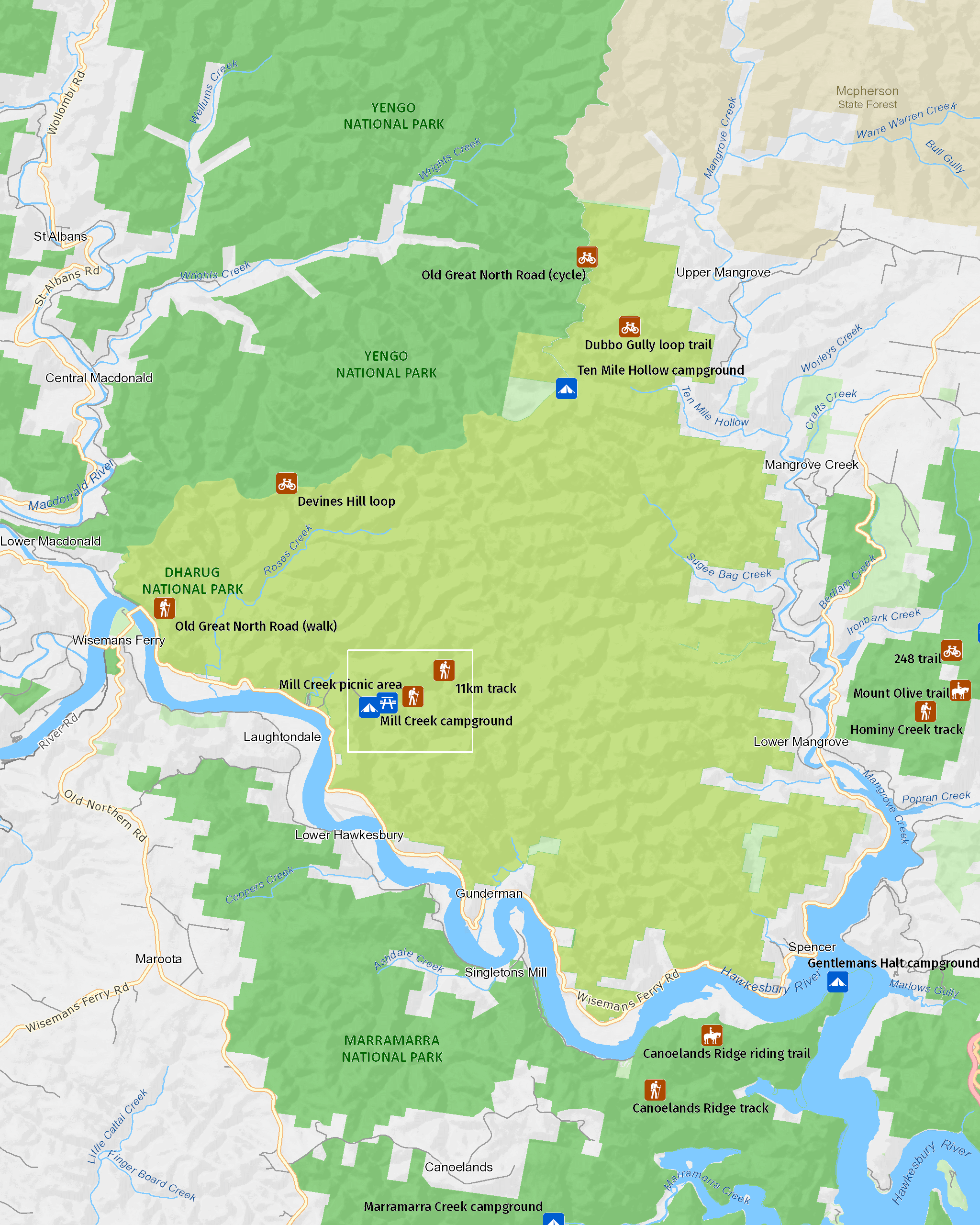
Map
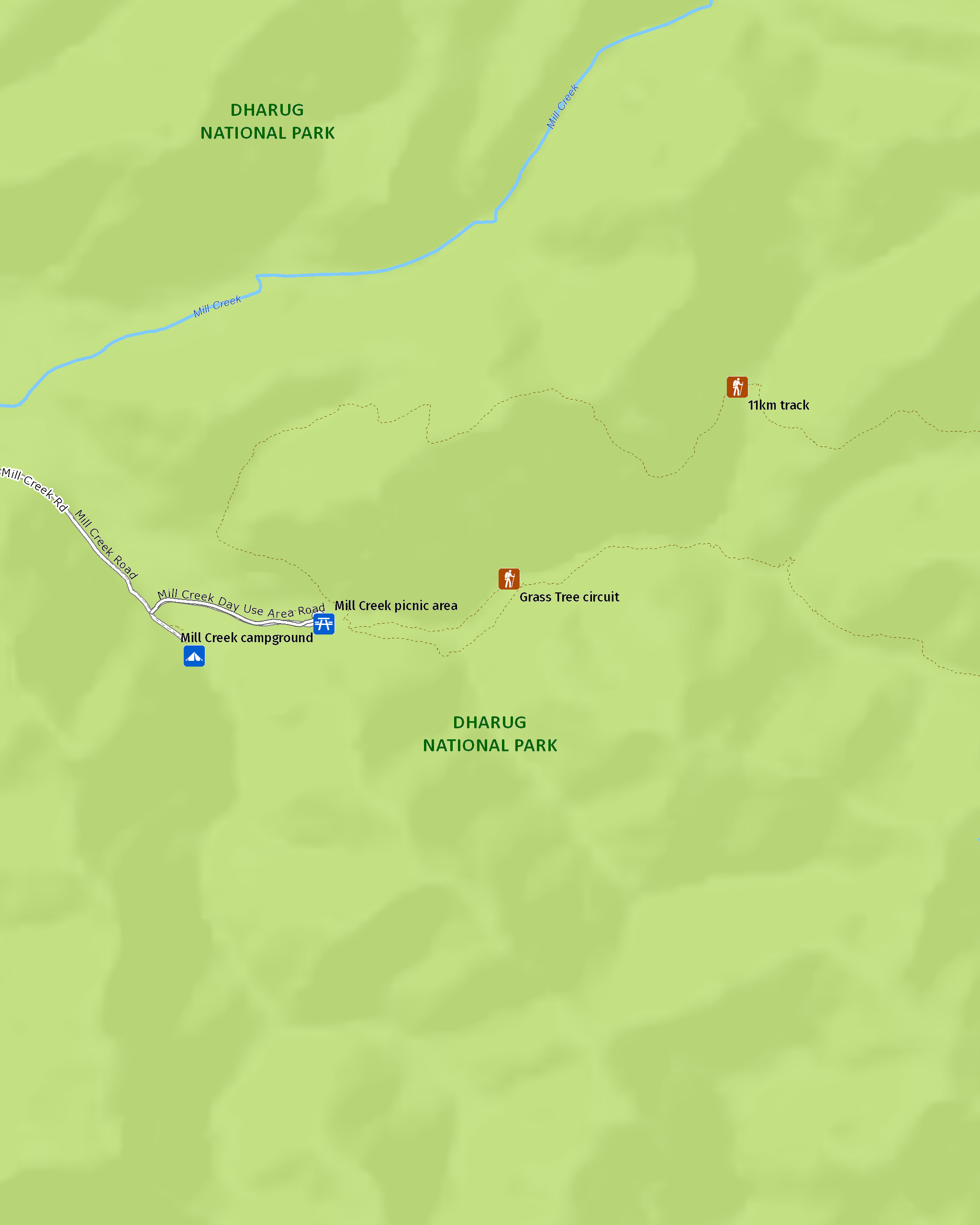
Map legend

Contact
- in the Sydney and surrounds region
Dharug National Park is always open but may have to close at times due to poor weather or fire danger.
-
-
Bulga office
02 6574 5555
Contact hours: Monday to Friday, 9.30am to 4pm. - 2156 Putty Road, Bulga NSW 2330
-
Email: npws.wollemiyengo@environment.nsw.gov.au
-
Bulga office
Visitor info
All the practical information you need to know about Dharug National Park.
Getting there and parking
Get driving directions
From Sydney take Galston Road from Hornsby or the Old Northern Road from Castle Hill or Dural, these roads join at Middle Dural to become the Old Northern Road. This takes you north to Wisemans Ferry, where you can take your car across the Hawkesbury river on the car ferry or leave it on the south side and cross as a pedestrian to enter the park. From Gosford and the Central Coast take Peats Ridge Road off the F3 and then Wisemans Ferry Road from Central Mangrove to the Mill Creek campground and picnic area.
Parking
- Mill Creek campground See on map
By bike
Check out the Bicycle information for NSW website for more information.
Best times to visit
There are lots of great things waiting for you in Dharug National Park. Here are some of the highlights.
Autumn
The water has warmed up nicely by late summer so autumn is great for kayaking and canoeing along the Hawkesbury river.
Spring
The spring months are perfect for enjoying more strenuous activities in the park, like the longer walks and mountain bike riding. It's also the perfect time to see wildflowers.
Winter
The park is still stunning in winter and walking on sunny days is very pleasant. It can be cold at night so bring warm gear if you're camping.
Weather, temperature and rainfall
Summer temperature
Average
13°C and 27°C
Highest recorded
42.9°C
Winter temperature
Average
8°C and 18°C
Lowest recorded
-0.1°C
Rainfall
Wettest month
February and March
Driest month
September
The area’s highest recorded rainfall in one day
230.2mm
Facilities
Toilets
Picnic tables
Barbecue facilities
Drinking water
Maps and downloads
Prohibited
Pets
Pets and domestic animals (other than certified assistance animals) are not permitted. Find out which regional parks allow dog walking and see the pets in parks policy for more information.
Smoking
NSW national parks are no smoking areas.
Nearby towns
Windsor (48 km)
Explore Windsor's historic buildings, including St Matthew's Anglican Church (1817), Windsor Court House (1822), and the Macquarie Arms Hotel (1815). Bring a picnic or your boat and enjoy the beautiful riverside parks in Windsor including Howe Park and Governor Phillip Park.
Sydney City Centre (80 km)
No trip to Sydney is complete without spending some time in the city’s beautiful parks. Whether it’s in central areas like Hyde Park or the Royal Botanic Gardens or further out in Centennial Parklands, there’s plenty of green space to go out and enjoy.
Hawkesbury area
Explore the beautiful Hawkesbury River with Australia's Last River Boat Postman, or sample fresh oysters at a casual riverside cafe. Start your Hawkesbury adventure with a seaplane flight from Sydney to a local restaurant by the river.
Learn more
Dharug National Park is a special place. Here are just some of the reasons why:
Step into Australia’s past
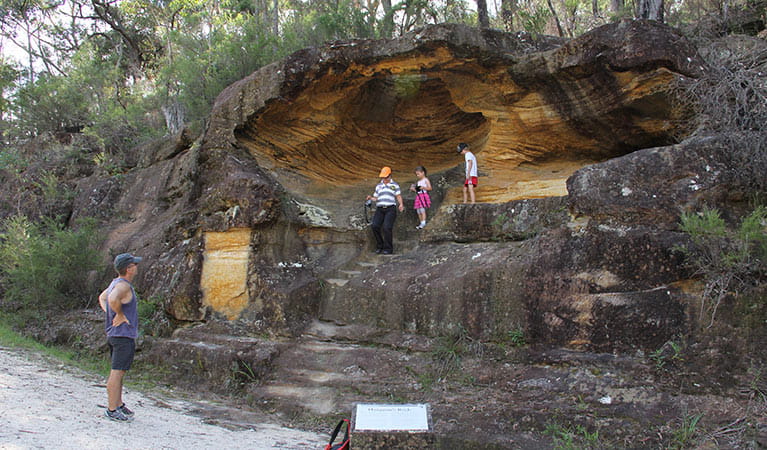
Dharug National Park contains the Old Great North Road, one of 11 historic sites which form the Australian Convict Sites World Heritage property. It's a spectacular example of early colonial engineering and demonstrates the use of convict labour; up to 720 convicts - some in chains - worked on the road, which spanned 264km, connecting Sydney to the settlements of the Hunter Valley. Only 43km of the road remains relatively intact, running from Wisemans Ferry in the south to Mount Manning in the north and includes the oldest surviving stone bridges in mainland Australia. It makes a great walk to explore over two or three days or an exhilarating day's cycle.
- Devines Hill loop Head to Devines Hill loop in Dharug National Park, near Wisemans Ferry this weekend for a bike ride or walk along the historic World Heritage-listed Devines Hill loop.
- Old Great North Road - World Heritage walk Old Great North Road – World Heritage walk highlights a historic convict-built road with scenic river views, via Finchs Line, in Dharug National Park.
Rugged beauty
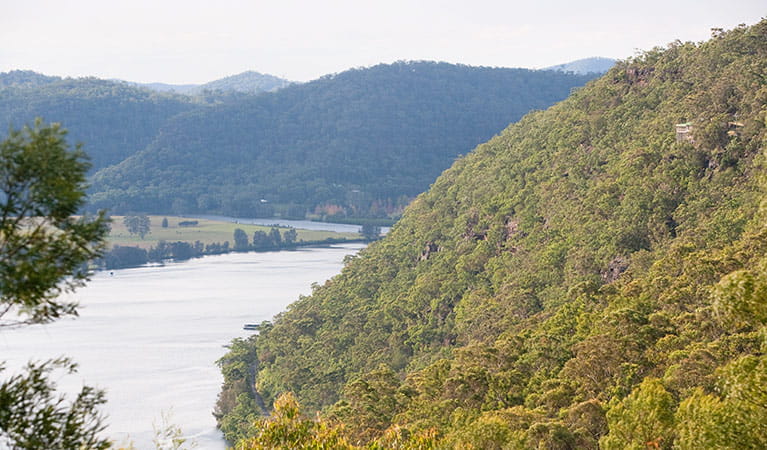
From the rugged bushland containing gang-gang cockatoos, satin bowerbirds and Lewin's honeyeaters to the sparkling waters of the creeks and the rich colours of the sandstone cliffs and formations, Dharug National Park offers a diverse range of landscapes. Bring your bike, bushwalk, camp by the creek, canoe on the Hawkesbury or make the most of the backdrop with your camera, there is so much to explore.
Aboriginal heritage
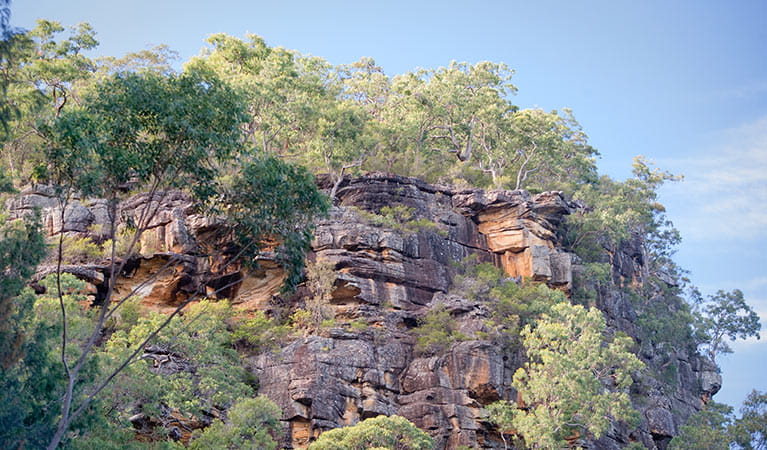
Dharug National Park is the traditional Country of the Dharug Aboriginal people. Abundant in animal, plant and bird life, the area was a rich source of food, medicines and shelter. The park's diverse landscapes and all they contain feature in all aspects of Aboriginal culture and are associated with Dreaming stories and cultural learning that is still passed on today.
Plants and animals protected in this park
Animals
-

Superb lyrebird (Menura novaehollandiae)
With a complex mimicking call and an elaborate courtship dance to match, the superb lyrebird is one of the most spectacular Australian animals. A bird watching must-see, the superb lyrebird can be found in rainforests and wet woodlands across eastern NSW and Victoria.
-
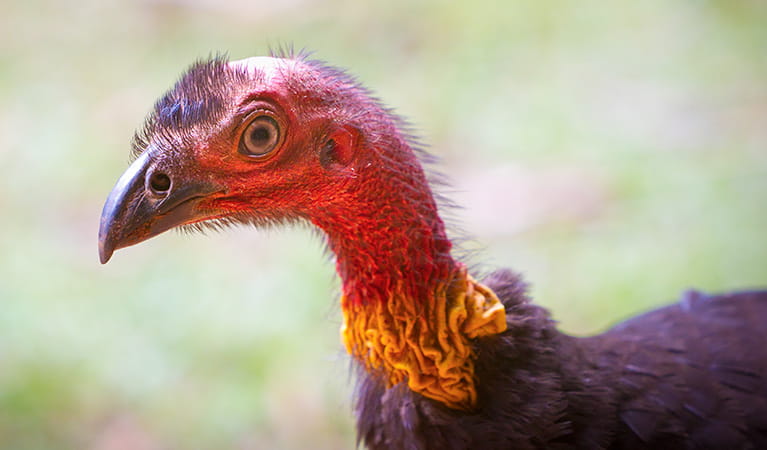
Australian brush turkey (Alectura lathami)
The Australian brush turkey, also known as bush or scrub turkey, can be found in rainforests along eastern NSW. With a striking red head, blue-black plumage and booming call, these distinctive Australian birds are easy to spot while bird watching in several NSW national parks.
-

Bare-nosed wombat (Vombatus ursinus)
A large, squat marsupial, the Australian bare-nosed wombat is a burrowing mammal found in coastal forests and mountain ranges across NSW and Victoria. The only other remaining species of wombat in NSW, the endangered southern hairy-nosed wombat, was considered extinct until relatively recently.
-
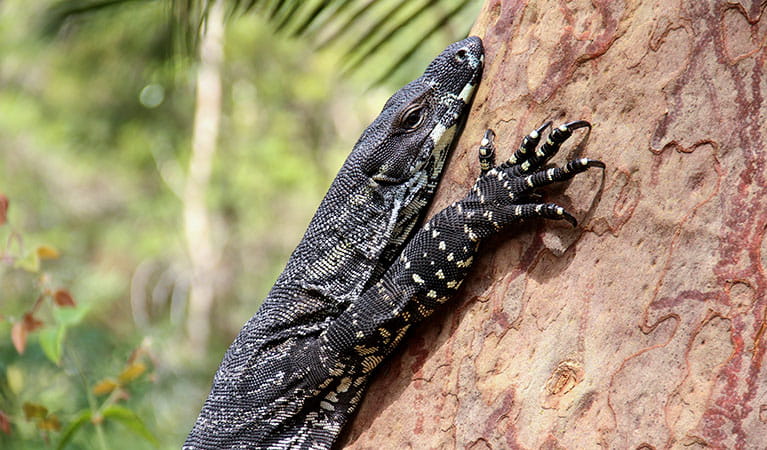
Lace monitor (Varanus varius)
One of Australia’s largest lizards, the carnivorous tree-dwelling lace monitor, or tree goanna, can grow to 2m in length and is found in forests and coastal tablelands across eastern Australia. These Australian animals are typically dark blue in colour with whitish spots or blotches.
Plants
-
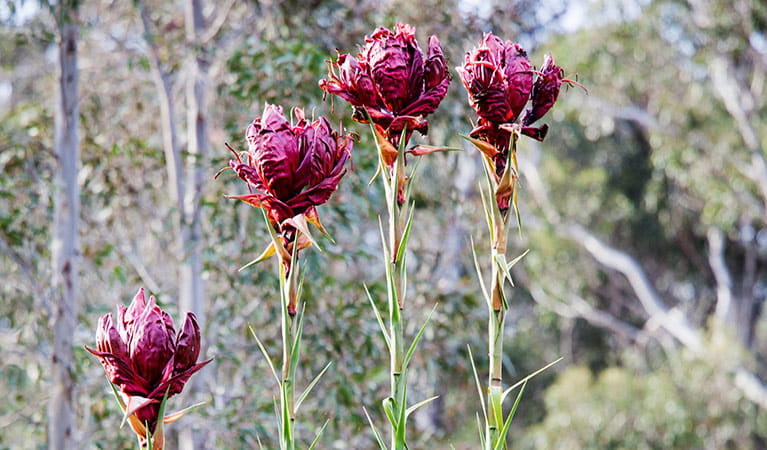
Gymea lily (Doryanthes excelsa)
The magnificent Gymea lily is one of the most unusual Australian native plants, found only along the coast and surrounding bushland of the Sydney Basin, from Newcastle to Wollongong. In spring this giant lily shoots out spectacular red flowers that can reach heights of 2-4m.
Environments in this park
Education resources (1)
What we're doing
Dharug National Park has management strategies in place to protect and conserve the values of this park. Visit the OEH website for detailed park and fire management documents. Here is just some of the work we’re doing to conserve these values:
Managing weeds, pest animals and other threats
Pests and weeds have a significant impact to the ecosystems within Dharug National Park. Risk assessments for new and emerging weeds are carried out as an ongoing initiative within the park. Pest management of wild dogs is a priority and an important part of the work NPWS does to protect the integrity of biodiversity which exists within Dharug.
Exploring World Heritage
Dharug National Park incorporates the Old Great North Road, one of 11 historic sites which form the Australian Convict Sites World Heritage property. NPWS protects and conserves the road’s historic significance through a variety of initiatives. These aim to retain and recover the road’s World Heritage values, while ensuring no further negative impact. NPWS liaises with park neighbours and authorities as required.
Managing fire
NSW is one of the most bushfire prone areas in the world as a result of our climate, weather systems, vegetation and the rugged terrain. NPWS is committed to maintaining natural and cultural heritage values and minimising the likelihood and impact of bushfires via a strategic program of fire research, fire planning, hazard reduction, highly trained rapid response firefighting crews and community alerts.

